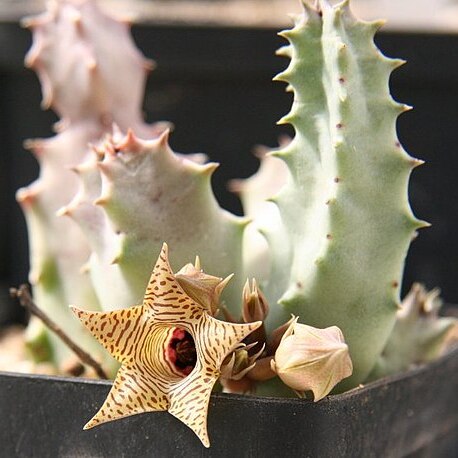Perennial, dwarf succulent. Stems erect to decumbent, 30-60 mm long, 4-or 5-angled, tuberculate, glabrous, green. Flowers developing successively; pedicels up to 35 mm long. Sepals 6-7 mm long. Corolla 25-30 mm in diam., campanulate with minute asperities often bearing a short hair, cream-coloured to yellowish green with variable amounts of shiny maroon, rarely with reddish transverse lines; lobes spreading, 6-9 x 5-7 mm with prominent intermediate lobes; papillate in mouth of tube, papillae tipped with a stiff, straight hair up to 2 mm long. Corona purple-black ± 4.5-5.0 mm in diam.; outer lobes spreading, bifid, ± 1 x 1.5 mm; inner lobes awl-shaped, connivent over anthers, apex widely divergent-recurved.
Perennial, dwarf succulent. Stems ascending to erect, 38-64 x 12-25 mm, 4-or 5angled, tuberculate, glabrous, grey-green to purplish. Flowers 3-6; pedicels 8-25 mm long. Sepals 3-5 mm long. Corolla 25-40(-45) mm in diam., ± rotate with bowl-shaped tube, sometimes with a slight annulus, cream-coloured to yellowish with red-brown spots merging into broken lines in tube; lobes abruptly spreading; mouth of tube and lobes densely papillate, papillae often dark-tipped, sometimes bearing a short hair. Corona variable, outer lobes crimson to whitish, oblong, 1.5 mm long, deeply bifid, spreading; inner lobes 1.50-3.25 mm long, purple-brown, awl-shaped, incumbent on anthers with apex connivent-erect over column.
Perennial, dwarf succulent. Stems decumbent to erect, ± 50 x 8-10 mm, 4-or 5(6)-angled, tuberculate, glabrous, green. Flowers many; pedicels up to 25 mm long. Sepals ± 5 mm long. Corolla size variable, up to ± 25 mm in diam., rotate, cream-coloured to yellowish, with or without red markings; tube subglobose, mouth slightly constricted; lobes spreading, sometimes convex, up to 9 mm long, lobes and upper half of tube usually papillate. Corona: outer lobes variable, crimson to black, spreading, triangular to subquadrate, emarginate; inner lobes brown to black, 1.5-2.0 mm long, connivent-erect, flattened, tapering to finely tuberculate apex.
Like H. barbata but flowers campanulate, cream-coloured, sometimes finely spotted with red to brown, smooth or covered with conical papillae each with short apical hair.
Corona outer lobes usually cream-coloured or whitish, inner lobes with apices widely divergent.
Corolla unmarked, usually prominently papillate, sometimes with a low annulus.
Corolla unmarked cream-coloured to yellowish, sometimes with a low annulus.

